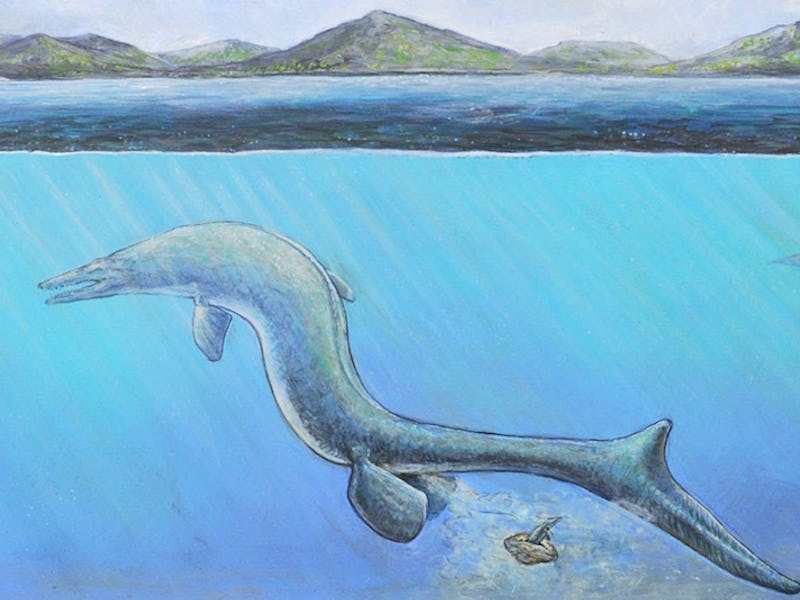First Antarctic egg belonged to an ancient sea monster — study
Until now, this mysterious fossil was only known as "The Thing."

After nearly a decade of mystery, scientists have confirmed that an unusual fossil from Antarctica is actually a massive egg — and it may have belonged to a real-life Loch Ness Monster.
The fossilized, soft-shelled egg is the biggest discovery of its kind, and the first-ever egg to turn up on the Earth's southernmost continent. The 66-million-year-old egg likely came from a giant, ancient reptile, reports a study published on Wednesday in the journal Nature.
Since its 2011 discovery, the egg fossil had puzzled researchers, who have likened it to a deflated football. The peculiar oval, which is about 11 inches long and 7 inches wide, earned a nickname among scientists that matched its mystery: "The Thing."
In the new findings, researchers used microscopic analysis to confirm that the fossil is indeed an ancient egg. Researchers analyzed the body size of 260 living reptiles, compared with their egg sizes, to estimate that the animal that laid the egg would have been more than 20 feet long.
Unlike hard dinosaur eggs, The Thing is soft-shelled, like a turtle's egg. That suggests the egg belonged instead to a massive aquatic reptile — like the mosasaurus, an aquatic reptilian predator that lived in the Late Cretaceous.
"The Thing" is actually a giant egg.
"It is from an animal the size of a large dinosaur, but it is completely unlike a dinosaur egg," lead author Lucas Legendre, a postdoctoral researcher at The University of Texas at Austin, says. "It is most similar to the eggs of lizards and snakes, but it is from a truly giant relative of these animals."
The researchers say that the egg is similar to modern snake and lizard eggs, which are sometimes transparent and hatch moments after they're laid.
These eggs may have hatched moments after they're laid.
Who laid the egg? — Without a skeleton inside, paleontologists don't have any way of confirming what massive prehistoric creature laid The Thing.
But if it is indeed a mosasaurs' egg, the new finding would overturn what scientists have previously thought — that these ancient creatures didn't lay eggs. Since there are no living aquatic reptiles the size of a mosasaurus, the egg seems to be in a class of its own.
There are some encouraging clues: Researchers know that mosasaurs lived in Antarctica and the Antarctica rock formation where the egg was found also contained fossils from mosasaurs and plesiosaurs. Those fossilized remains have fascinated researchers and the public for centuries — in fact, some theories suggest that the pair directly influenced Loch Ness Monster lore.
In a 2019 study, researchers found that a type of "dino-mania" followed the discovery of creatures like mosasaurs and plesiosaurs. Essentially, people became collectively taken with the sea monsters, and they began to appear before people's very eyes. Those study authors partially proved a theory laid out by American science fiction writer L. Sprague de Camp:
"After Mesozoic reptiles became well-known, reports of sea serpents, which until then had tended towards the serpentine, began to describe the monster as more and more resembling a Mesozoic reptile than like a plesiosaur or mosasaur."
It stands to reason that you can't fear what you don't know — and after you've been exposed to a monstrous, 20-foot-long aquatic reptile predator, there's really no looking back.
Abstract: Egg size and structure reflect important constraints on the reproductive and life-history characteristics of vertebrates1. More than two-thirds of all extant amniotes lay eggs2. During the Mesozoic era (around 250 million to 65 million years ago), body sizes reached extremes; nevertheless, the largest known egg belongs to the only recently extinct elephant bird3, which was roughly 66 million years younger than the last nonavian dinosaurs and giant marine reptiles. Here we report a new type of egg discovered in nearshore marine deposits from the Late Cretaceous period (roughly 68 million years ago) of Antarctica. It exceeds all nonavian dinosaur eggs in volume and differs from them in structure. Although the elephant bird egg is slightly larger, its eggshell is roughly five times thicker and shows a substantial prismatic layer and complex pore structure4. By contrast, the new fossil, visibly collapsed and folded, presents a thin eggshell with a layered structure that lacks a prismatic layer and distinct pores, and is similar to that of most extant lizards and snakes (Lepidosauria)5. The identity of the animal that laid the egg is unknown, but these preserved morphologies are consistent with the skeletal remains of mosasaurs (large marine lepidosaurs) found nearby. They are not consistent with described morphologies of dinosaur eggs of a similar size class. Phylogenetic analyses of traits for 259 lepidosaur species plus outgroups suggest that the egg belonged to an individual that was at least 7 metres long, hypothesized to be a giant marine reptile, all clades of which have previously been proposed to show live birth6. Such a large egg with a relatively thin eggshell may reflect derived constraints associated with body shape, reproductive investment linked with gigantism, and lepidosaurian viviparity, in which a ‘vestigial’ egg is laid and hatches immediately7.